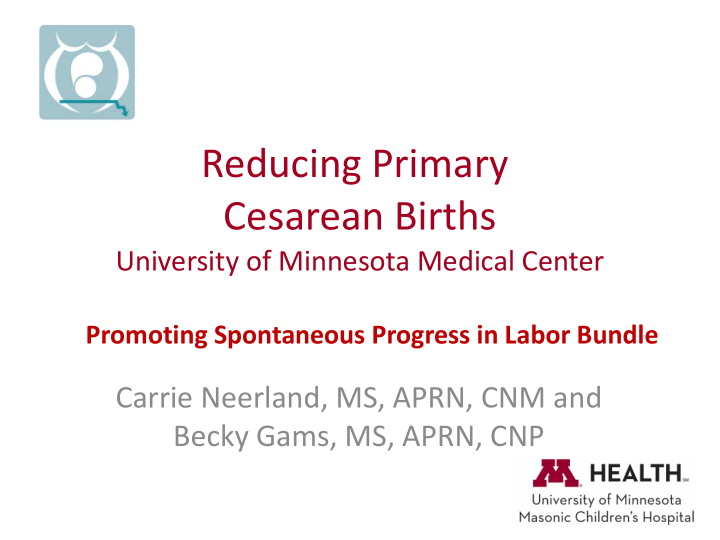



Reducing Primary Cesarean Births University of Minnesota Medical Center Promoting Spontaneous Progress in Labor Bundle Carrie Neerland, MS, APRN, CNM and Becky Gams, MS, APRN, CNP
Introducing the Reducing Primary Cesarean Initiative at UMMC – This is our story • Submitted application and letters of support from Medical Director and Nursing Administration • Accepted! • Attended a meeting with 19 other institutions from across the U.S. • Chose a Bundle: Promoting Spontaneous Progress in Labor
Building the Multidisciplinary Team Members of the team • Nursing • Advanced Practice Nurse Leader • Clinical Development Specialist • Nurse-Midwifery • DNP Students • Obstetrics/Residents • Anesthesia • Medical Students • Nursing Administration • Medical Director
Utilizing Principles of Change Management • PDSA cycles • Building the multidisciplinary team • Building the infrastructure • Incorporating the initiative into already established processes • Having a shared mental model…
First Steps • Created a Team Charter • Avenues for Early Communication: Standing agenda item Obstetric Interdisciplinary Team meetings Nursing Staff Meetings Bulletin boards on all of the Birthplace units – including Mother/Baby unit Recruited several interdisciplinary team members – Buzz on the Birthplace
Bundle Elements of the Physiologic Progress of Labor Bundle • Is there an established interprofessional policy for labor care that specifies: – a) evidence based criteria for diagnosing active labor? – b) describes the system of communication to signal physiologic parameters of labor duration have been exceeded? – c) triggers a protocol for intervention consideration? • Are there objective criteria to assess a woman's stage of labor? • Are women informed of their stage in labor?
Physiologic Process of Labor Bundle • Is there documentation of the maternity care professional training and skill development regarding use of evidence- based care practices that promote the progress of spontaneous labor? • Does the OB department tracks and publically reports rates of physiologic childbirth? • Is there a policy for routine, interdisciplinary review of all operative births performed for the indication of labor progress disorders?
New Guidelines • New Guidelines: • Labor Support and Upright Positioning Guideline including use of birth slings • Early Labor Assessment and Management Guideline including use of labor lounge • Revised Guideline: • Fetal Monitoring Guideline to include updated Intermittent Auscultation Guidelines
Nursing and Provider Education Labor Support and Upright Positioning: Early Labor Assessment and • Online education Management • Video on use of slings • Use of whiteboard to • Incorporation into labor and delivery enhance communication of classes for new nurses – hands on • Presented at internal nursing stage of labor conference with demos and hands- • How to use early labor on skill training lounge at RN Competencies • Checklist for safe set-up and use of birth slings and OB provider meetings • Unit champions for checklist and • Clear recommendations for mentoring inpatient admission
Nursing and Provider Education Intermittent Auscultation • Incorporation into Labor and Delivery classes for new nurses • Topic at two internal nursing conferences • Nursing competencies • Review at OB provider meeting
Early Labor Lounge
Birth Sling Video and RN Competency Checklist
Infrastructure for Data Collection • Data Collection and Documentation Revisions in EMR – Developed a data collection worksheet – Delivery Summary for data collection (Epic) • 1:1 labor support, IA, dilation at epidural placement, CNM care, nitrous oxide – Intermittent Auscultation drop downs in the flow sheets (Epic) – Delivery Log report for data pulling (Excel) • Gloria (from IT) changed our lives • Facilitated ease for pulling NTSV cases and for filtering • Reduced the time for data collection from 8 minutes to approximately 30 seconds • Almost all data pulls to a report – – we are almost out of the chart!
Worksheet for data collection This worksheet was used until the EMR was updated to capture data and is used by Our RPC data collection RN to capture data that did not get entered in the delivery summary
Intermittent Auscultation in EMR
Utilizing the Evidence • Compliance with Preventing First Cesarean Guideline – OB resident and medical student reviewing cases quarterly to determine compliance with SMFM/ACOG criteria – Spong algorithm readily available on the unit in each patient room – Review non-compliant cases in OB Case Review for learning opportunities – Team HUDDLES in the works • To occur when considering cesarean for labor dystocia • Review the algorithm to ensure criteria are met • Smart text note in development to ensure documentation
Algorithm for Spontaneous labor Spong, et al, Preventing the First Cesarean Delivery. Obstet Gynecol 2012
Spong, et al, Preventing the First Cesarean Delivery. Obstet Gynecol 2012
C/S Huddle Checklist: Indication Labor Dystocia
Chose one diagnosis and document there.
Collaborative NTSV Rate Jan 2015 to Sept 2016
UMMC C-Birth Rate for NTSV Inductions January 2015 through July 2016 13.6%
UMMC NTSV Cesarean Rate January 2015 through July 2016 14.1%
Continuous Labor Support Feb 2016 through July 2016
Spontaneous Labor and Delivery Rate Feb 2016 through July 2016 42 out of 78 births met this criteria in July – 53.8%
Physiologic Birth No epidural, no oxytocin, no c/s Feb through July 2016 (14.1% in July)
UMMC NTSV Cesarean Rate • The Healthy People 2020 NTSV C/S goal is 23.9%. • Our AIM is to reduce our NTSV C/S rate by 3% in 2016 and another 3% in 2017. • Our NTSV rate of C/S in 2015 was 29.3%. • From January to June 2016, our NTSV C/S rate is 26.2% • In July, our NTSV C/S rate was 14.1% and NTSV C/S rate for Inductions was 13.6%
We’re Down with RPC! Thank you!
Recommend
More recommend